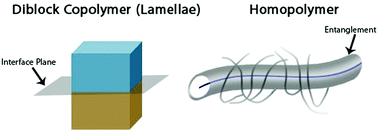Correlation between morphology and anisotropic transport properties of diblock copolymers melts†
Abstract
Molecular simulations of coarse-grained diblock copolymers (DBP) were conducted to study the effect of segregation strength and morphology on transport properties. It was found that in the strong segregation limit (i.e., high χN, where χ is the Flory–Huggins parameter and N is the degree of polymerization), the presence of the DBP interfaces imposes topological constraints similar to those of entanglements as manifested in the rheological signature of the polymer (i.e., a plateau modulus). Furthermore, compared to the behavior of isotropic melts, the crossover from Rouse to reptation scaling of the self-diffusion coefficient (D) parallel to the DBP interface takes place at a smaller N, an effect that depends on temperature and is more pronounced in the Lamellae morphology than in the hexagonal cylinder morphology. Additionally, it is shown that for an entangled melt (i.e., N ≫ Ne where Ne is the entanglement length) block retraction is instrumental for chains to diffuse parallel to the interface of lamellar layers. Lastly, it is found that the anisotropic viscosity of different morphologies is mostly affected by the orientation of the chains relative to the shear flow direction, exhibiting reduced values when chains align in the neutral or flow directions.



 Please wait while we load your content...
Please wait while we load your content...
